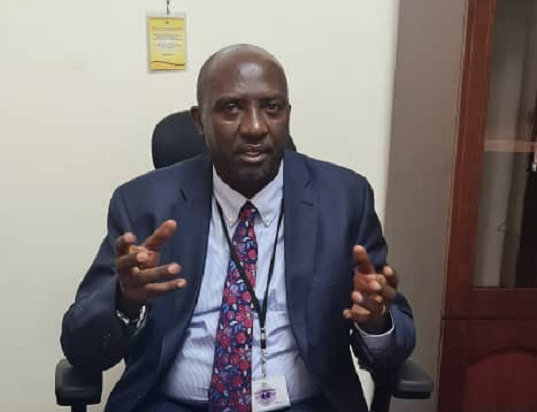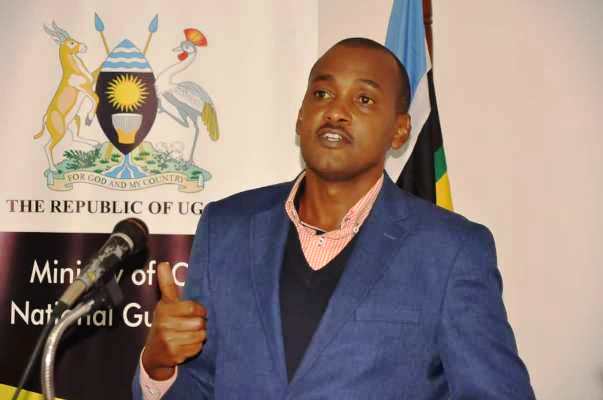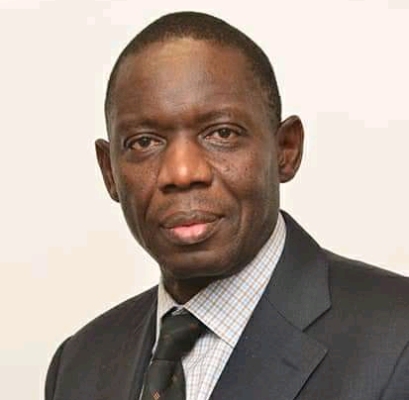Solar installation at Bulangira, in Kibuku District
The Ministry of Water and Environment (MWE) has recorded significant achievements in fulfilling the NRM 2021-2026 Manifesto Commitments. Below is the scorecard for the Ministry of Water and Environment in the last few years and focus areas in the next three years;
The Ministry of Water and Environment (MWE) is specifically responsible for the following key thematic areas:
(i) Rural Water Supply and sanitation
(ii) Small Towns Water Supply and Sanitation
(iii) Large Water Supply and Sanitation
(iv) Water Resources Management
(v) Natural Resources Management
(vi) Water for Production/Irrigation
SUMMARY OF THE SECTOR ACHIEVEMENTS
RURAL WATER SUPPLY AND SANITATION
The Ministry has to date constructed 150,837 water supply facilities comprising of 42,007 deep boreholes, 21,722 shallow wells, 29,261 protected springs, 37,480 Public Stand Post (PSP)/taps and 20,367 rainwater harvesting tanks.
It is estimated that 70 percent (33,180,420 people) (68% in the rural and 71.6% in the urban) of the current population have access to clean and safe water services while 30 percent (14,220,000 people) of the population are without access to clean and safe water services.
Out of the 70,512 villages in the Country, 49,102 villages representing (70%) have access to at least one safe water source. There are still about 21,410 villages (30%) without any safe and clean water source.
Completed water supply systems
Two piped water systems developed in Kibuku District, in Buseta Rural Growth Centre serving a population of 2,276 and Kasasira Rural Growth Centre serving a population of 5,676.
Lirima GFS Phase II serves a total of 40,800 persons.
Bukedea GFS Phase I serves a total of 60,624 persons.
Orom GFS, at the time of handover was serving a total of 13,344 persons.
Shuuku and Masyoro (Sheema District) was 100% completed and at the time of handover, there were 300 connections serving 7,200 persons.
Ongoing Construction Works
Nyabuhikye and Kikyenkye (Ibanda District) is 90% complete and has 1000 promotional connections.
Kabuyanda water supply and sanitation in Isingiro District is at 90% completion with 850 connections made to the system serving 20,400 persons.
Construction of Bitsya Gravity Flow System in Buhweju District; the contract was awarded and the contactor is mobilising to start works.
Construction of Nyamugasani Water supply system in Kasese District; the contract was awarded and the contractor is mobilising to start works.
Drilling of environmentally friendly boreholes Country wide
- 422 new point water sources including 323 hand pumped wells and 99 production wells have been drilled and constructed across the Country serving 126,600 persons. These interventions mainly focused on least served districts of Buvuma, Buyende, Bundibudgyo, Kakumiro, Kamuli, Kassanda, Kisoro, Kyegegwa, Mubende, Rakai, Wakiso, Yumbe, Kirumira, Lyantonde and Sembabule.
- Under the District Water and Sanitation Conditional Grant (DWSCG) to the District Local Governments (DLGs), 1,886 boreholes or hand pumped wells, 301 protected springs, 201 Rainwater Harvesting Tanks 10m3 and 14 valley tanks were constructed serving a total of 606,957 persons excluding 21 valley tanks that are for animals watering. In summary, a total of 1,322 new point water sources were constructed serving 431,075 persons.
Installation of 2,060 environmentally friendly and sustainable solar
powered boreholes to increase safe water coverage in the least served villages.
- Under the centrally managed projects, during the FY 2020/21, 40 Solar/ Wind Powered Water Supply Systems have been constructed to 80% completion with 187 public stands posts and 183 house connections currently serving 173,058 persons.
- With support from development partners, 100 mini solar powered pumping water systems for schools and health facilities with extension to nearby communities have been constructed in the districts of Adjumani, Arua, Kiryandongo, Moyo, Isingiro, Moroto, Napak, Amudat, Nakapipirit and Kotido serving 50,000 persons. A total of 223,058 persons were served.
Rehabilitation of old rural piped water supply schemes
- A total of 3,877 existing point water sources have been rehabilitated across the Country restoring water supply to 1,163,100 persons.
- With support from development partners, the Ministry of Water and Environment’s efforts under the emergency Water, Sanitation and Hygiene rehabilitated 9 Gravity Flow Systems/Solar Powered Systems restoring water supply to 27,600 persons.
- 3 solar powered water systems in Isingiro, Adjumani and Kiryandongo were upgraded serving 28,000 persons. Through the rehabilitation, upgrading and expansion of piped water system, 104,368 persons were served.
- 48 boreholes were rehabilitated restoring water supply to 14,400 persons in the Districts of Obongi, Buliisa, Kasese, Kaabong, Nabilatuk, Moroto and Karenga. In addition, 04 water supply systems were constructed and upgraded located at Kamwenge district (Kamwenge HCIII and Bigodi HCIII) and Kikuube district (Kyehoro HCIII and Muhwiju HCIII) serving 18,200 persons.
Promote rainwater harvesting by reducing the cost of acquiring
necessary equipment such as water tanks.
- There has been an increase in the uptake of rainwater harvesting across the country from 20,187 in FY 2020/21 to 20,367 in FY 2021/22.
Support continuous Community-Led Total Sanitation (CLTS) for
improved sanitation and hygiene to prevent diseases.
- Under the Transitional Development Grant – Sanitation (Water & Environment), a total of 4,040 villages were worked in and of these 4,040 villages, 19.9% (804) became open defecation free.
- Approximately a total of 241,2001 persons gained access to household sanitation.
URBAN WATER AND SEWERAGE SERVICES
Small Towns Water Supply and Sanitation
Completed Schemes:
- Kyenjojo (Kyenjojo), Katooke (Kyenjojo), Nakasongola(Nakasongola), Alerek (Abim), Dokolo, Buyamba (Rakai), Kassanda (Mubende), Kangulumira-Nazigo (Kayunga), Kagadi, Odramacaku (Arua), Moyo (Moyo), Morulem (Abim), Namalu (Nakapiripirit), Padibe (Lamwo), Lwamata (Kiboga), Kambuga II, Kateete HC III, Bigando (Kasese).
Ongoing construction of water supply systems
- Busia (69%-Busia), Kayunga (98%-Kayunga), Busaana (98%-Kayunga), Kamuli (19%-Kamuli), Buikwe (52%-Buikwe), Kapchorwa (69%-Kapchorwa), Bundibugyo (85%-Bundibugyo), Yumbe (99%-Yumbe). Igorora II (6%-Ibanda), Binyiny (93%-Kween), Bibia/Elegu (90%-Amuru), Atiak (75%-Amuru), Lacekocot (70%-Pader), Kyankwanzi (96%-Kyankwanzi),Nalukonge/Lusozi(96%-Kyankwanzi), Butemba/Bukwiri (96%-Kyankwanzi), Nyakatonzi (98%-Kasese), Ngoma (12%-Nakaseke), Okokolo (40.7%-Maracha), Kati (22%-Madi-Okolo), Alucokoko (5%-), Accumut (15%), Kokum (35%), Ocapa (70%-Serere), Amus (45%), Bulangira (40%-Kibuku), Kaguru (90%-Buyende), Kalapata (30%-Kaabong), Kakingol (15%-Moroto), Rhino Camp (35%-`Madi-Okolo), Keri-Oraba (33%-Koboko), Parabong (42%-Amuru), Zombo (5%-Zombo), Bukumi (5%-Mbale), Kanapa (1%-Katakwi), Apapai (98%), Odongai (95%-Kalaki), Bihanga (Kamwenge), Namasale (Site handover-Namasale), Kaliro (Site handover-Kaliro), Namungarwe (Site handover-Kamuli).
Construction of improved public sanitation facilities in public places and selected institutions, including cluster faecal sludge management facilities in small towns and rural growth centres.
- Completed construction of 29No. Public and institutional Sanitation Facilities in Kapchorwa, Kayunga, Busana, Nakasongola, Kyenjojo, Katooke.
- Construction of 11No. Institutional and Public Sanitation Facilities is ongoing in Bundibugyo, Kamuli, Buikwe.
- Completed construction of Dzaipi Feacal Sludge Management Facilities (FSMF).
- Construction of 3No. FSMF are on-going in Koboko, Rukungiri, Yumbe.
- Completed designing of 12No. FSMF for the small towns / Rural Growth Centres of Wobulenzi, Kigumba, Buikwe, Dokolo, Kyenjojo, Namutumba, Kira, Patong, Kyazanga, Kanungu, Moyo and Kapchorwa.
NATIONAL WATER AND SEWERAGE CORPORATION (LARGE TOWNS WATER SUPPLY AND SEWERAGE)
All Cities, Towns, Trading Centers, Wards, Cells and zones to get clean safe water (at least one source per village).
- The Corporation’s geographical coverage has grown by 3% from 258 tons to 268 towns (an additional 10 towns). These towns are located in 94 districts across the Country, and constitute 11 cities, 257 towns and 16,601 villages. Currently, the village service coverage stands at 65% (10,799 villages with at least one safe water point).
Improving Urban Water Supply and Sewerage Coverage
- The Corporation’s aspiration is to increase its water service coverage from 74% to 86% in 2026 and sewerage service coverage from 21% to at least 30%.
- Currently, the water service coverage stands at 78% while sewerage service coverage at 23%. This denotes an improvement of four (4) percentage points from 74% to 78%.
Implementation of Capital Development Projects to enhance water and sewerage service delivery
Completed Projects
- Construction of the Katosi Water Treatment Plant, which increased daily water production by 160 million litres, from 240 million litres in 2020 to 400 million litres in Kampala Metropolitan.
- Upgrading of Kapeeka Water Supply System, which enhanced daily water production from 2.5 million litres to 5 million litres. The Project has improved water supply services delivery in Kapeeka plus the neighbouring towns of Semuto and Bukomero among others. In addition, 15 projects/industries have benefited from the upgrade of the production system in the Industrial Park.
- Rehabilitation and expansion of the Sembabule Water Supply Project. The Plant is now able to produce 3 million litres of water daily as opposed to the 300,000 litres initially. Connected 450 new customers to the project line. New areas served under the project include; Lugusuru, Kisozi, Kajjumiro trading centre and Nanseko.
- Fort Portal Water Production Improvement Project. Current production capacity is 5 million litres per day compared to 2.5 million litres initially.
- Development of Parombo Water System to serve over 20,000 people in the area following the Presidential Directive in 2018 for NWSC to extend water to Parambo town. Daily Water supply improved by 200,000 litres.
- Water for Virungas Project – Kisoro aimed at improving water supply in the 17 villages around the Virunga ranges, to deter the locals from entering the Mgahinga National Park to compete with the Animals for water.
- Upgrading of the Kisoro – Nkanka Water Supply System from 3.1 million litres daily to 5.8 million litres.
- Jinja – Iganga Water Supply Improvement Project that improved daily water production by 6 million litres. The system serves an additional 300,000 people in over 200 Villages in Jinja, Iganga, Mayuge, Kayunga and Buikwe.
- Upgrading of the Hoima Water Supply, which has improved water supply in Hoima City by an additional 3.5 million liters daily. The System will enhance water supply services within Hoima City and the Areas of Kasengo district Headquarters, Kihukia Busisi, Budaka, Kiduma, Kalongo, and Kyesiga among others, which have been affected by intermittent water supply.
- Lyantonde Water Supply Project intended to enhance daily water production by 3 million liters daily. This will improve water supply services in the areas of Lyantonde, Rushere and Rushara Industrial Park.
- Nakivubo Waste-Water Treatment Plant with capacity of 45 million liters daily. The system was completed and is undergoing performance monitoring. The Plant is to serve an additional 380,000 people in Kampala Metropolitan. The Plant will also produce an average of 180kwh per day of electricity sufficient to meet 70% of the plant energy requirement.
- Kiruddu Waste Water Treatment Plant with a capacity of 300,000 liters daily targeting Kiruddu Hospital and the surrounding community. The project is substantially completed and is under testing.
Water supply for the planned Industrial Parks
- NWSC has established water supply systems for nine (9) of the well-developed industrial parks and various businesses have been connected to the Water System.
Water for Production
- The irrigation area has increased from 19,138ha to 22,797ha against the irrigation potential estimated at 3.03 Million Hectares country wide.
- The overall current cumulative water storage for Water for Production has increased from 42.025 Million Cubic Meters to 52.48 Million Cubic Meters (MCM).
- Functionality for Water for Production facilities stands at 88%.
- The Ministry has completed the construction of Seven (07) communal Valley Tanks of Karengese in Nakapiripirit District, Napeikar, Loteteleit, Kalopedomuge and Lokipworanaron in Kotido District, Auskuyon and Katotin in Amudat District. This has created a total water storage of 140 Million Litres for Livestock watering.
- The Ministry has also completed the construction of 09 communal Valley Tanks of Nadwaramukuny, Lochurut and Longoromit in Kaabong District, Longorikipii and Arengetekat in Nabilatuk District, Omagal in Abim District, Itanya-Kanyikwar-Loyoro, Lokoripii and Tapwa in Karenga District in Karamoja Sub-region. This has created a total water storage of 180 Million Litres for Livestock watering.
- Completed construction of Seventy-Eight (78) private Valley Tanks on individual farms to date using the Water for production equipment in the Districts of Isingiro, Ntungamo, Sembabule, Nakasongola, Nakaseke, Gomba, Bukomansimbi, Ibanda, Kiruhura, Lyantonde and Mbarara.
- Completed construction of Twenty-Six (26) Communal Valley Tanks for livestock watering in the districts of Mbale, Tororo, Mbarara, Kiryandongo, Nwoya, Kibaale, Kiruhura, Isingiro and Sembabule.
- Construction on going for nine Communal Valley Tanks in the Districts of Ntungamo, Ntoroko, Kyotera, Kamwenge, Kyotera, Pader, Omoro, Kibaale, Gomba.
- Completed construction of six medium scale Irrigation Schemes of Doho II, Mubuku II, Tochi, Ngenge, Rwengaaju and Olweny in the Districts of Butaleja, Kasese, Oyam, Kween, Kabarole and Lira respectively. This has increased the area under formal irrigation by 3,976 Hectares benefiting 5,328 farmers. The main enterprises are rice and horticulture (onions, green pepper, tomatoes, watermelons and cabbages).
- Works are in advance stages of completion for construction of Wadelai (1,000 Ha) irrigation scheme in Pakwach District in Northern Uganda.
- Works have commenced for construction of two irrigation schemes in the Districts of Bududa (Namaitsu) and Luweero (Kawumu). These will increase crop production after completion.
Solar Powered Irrigation Demonstration sites
- Thirty-Five (37) Solar Powered Irrigation Demonstration sites were constructed in the Districts of Buhweju (1), Isingiro (1), Kiruhura (1), Kyenjojo (1), Mbarara (1), Ntungamo (2), Rukungiri (2), Rwampara (1), Rubirizi (1), Mbale (1), Kapchorwa (1), Namayingo (1), Tororo (1), Soroti(1), Sironko (1), Serere (1), Katakwi (1), Karenga (1), Abim (1), Kasanda (1), Kibaale (1), Kasanda (1), Buvuma (1), Lwengo (2), Kyankwanzi (1), Kiryandongo (1), Kayunga (2), Lyantonde (1), Omoro (1), Dokolo (1), Oyam (1), Zombo (1) and Nwoya (1).
- Construction of twenty-two (22) Solar Powered Irrigation Demonstration sites is ongoing at various stages of progress in the Districts of Mayuge (1), Bududa (1), Kalangala (1), Nakaseke (1), Hoima (1), Oyam (1), Nwoya (2), Omoro (1), Agago (2), Kole (1), Apac (1), Omoro (2), Oyam (1), Zombo (1), Gulu (1), Kotido (1), Amudat (1), Bududa (1) and Adjumani (1).
ENVIRONMENT AND NATURAL RESOURCES
- The Ministry developed a number of initiatives as part of the Government campaign to plant and grow up to 40 million trees under the Running Out of Trees-ROOTS campaign. A number of partners were mobilized under the ROOTs campaign including churches, schools, corporate companies, and traditional and cultural institutions.
- A total of 26,394,856 assorted tree seedlings were planted. Sixty-six districts reported planting trees under different initiatives.
- In line with the manifesto’s objective of intensifying tree planting on individual and commercial farms, a total of 20,923,390 assorted tree seedlings have been distributed so far to individual farmers, community groups and institutions like schools, churches, kingdoms.
- Local communities have been supported to establish small woodlot plantations for production of saw logs and wood energy in rural areas. Twelve community groups have been supported with a total of 85,000 assorted tree seedlings groups resulting in establishment of approximately 76.51 ha of woodlots for the purpose of producing fuel wood.
NATIONAL FORESTRY AUTHORITY
- Raised 51,456,098 (64.3%) seedlings out of the planned two-year target of 80,000,000.
- NFA established 1,082Ha (54.1%) out of the planned 2,000ha in eight (8) plantation areas of Mwenge, South Busoga, Lendu, Mbarara, Mafuga, Katugo, Usi and Opit.
- Restored 14,131Ha (59%) out of the planned two-year target of 20,000Ha, in Lakeshores, Kyoga, Southwest, Muzizi and West Nile Ranges.
- Boundaries opened and marked with concrete pillars: 1,122.38Km (56%) out of the planned 2,000Km of Central Forest Reserve boundaries were reopened and marked with concrete pillars across the 14 Range and Plantation areas.
UGANDA NATIONAL METEOROLOGOCAL AUTHORITY
- Produced three (03) Seasonal Rainfall Outlooks annually to guide weather and climate users in decision making based on forecasts.
- Developed a Weather Information Dissemination System in partnership with College of Computing, Makerere University to support dissemination of Early Warning Information. UNMA acquired a USSD code (*201#) from Uganda Communication Commission (UCC) that can be used by stakeholders to access climate information
- Provided early warning information on weather and climate at different timescales: Six hourly, daily, 10 days, and monthly weather updates, as well as marine weather information (12 hourly) and aeronautical meteorological information.
- Operated and maintained 58 Automatic Weather Stations, 38 Manual Weather stations and 80 Rainfall stations to transmit data from the field station to the headquarters.
- Installed 1 Automatic Weather Station at Soroti University, 1 Automatic Weather Station at Lake Mburo, and 1 Automatic Weather Station at Kabaale Airport in Hoima.
- Installed 9 weather buoys; 6 installed on Lake Victoria, 2 on Lake Albert and 1 on Lake Kyoga.
Future Plan for Improved Performance
These include among others;
- Institutional strengthening, environment protection and catchment management.
- Improve forest law enforcement and governance through professional investigation and prosecution of environmental and forestry crimes.
- Increase public engagements and awareness on dangers of deforestation, climate disasters and opportunities for environmental restoration.





